Popular
- Manage License (Add on)
- Bulk Revoke
- Generating Access Code
- Direct Distribution (Add On)
- Creating Single User or Multiple Users (Bulk Upload)
- Admin Center and Profile and Settings
- Revoking Content
- Distributing Content
- Signing in to Kitaboo
- Promote User/Transfer
- Create Class/Update Class
- Selective Oneroster Sync with API/ZIP/SFTP
- Analytics Dashboard and Reports Overview
- How Kitaboo Reader – Text-to-Speech (TTS) Works
- Activated User – Definition & Billing Policy
- Understanding User Roles: Producer vs. Admin
- Auto Book Deletion Process
- Adding group with SAML
- Syncing Data with Clever
- Selective Oneroster Sync with API/ZIP/SFTP
- Syncing Data with PowerSchool
- Syncing Data with OneRoster
- Adding a Group
- Searching a Customer
- Issuing Licenses
- Editing a Customer
- Deactivating a Customer
- Adding a Google Classroom Customer
- Adding a OneRoster Customer
- Adding One roster 1.2
- Adding a LTI 1.3 Customer with OneRoster
- Adding a LTI 1.3 Customer
- Adding an LTI 1.1 Customer with OneRoster
- Adding LTI 1.1 Customers
- Sorting Customer and Group
- Enable K-AI at the content level
- Content Lifecycle Stages in Kitaboo for eBooks
- Creating a Fixed-layout Kitaboo eBooks
- Creating Fixed-layout ePub 3.0
- Upload 3rd Party ePub 2.0/3.0
- Creating a Course
- Activity or Gradable Activity Creation
- Authoring an ePub
- Creating a Video Book
- Creating an Audio Book
- Updating the Cover Image
- Editing a Fixed eBook
- Deleting and Deactivating Content
- Users Tab
- How to Edit and Delete a Category
- Clever Integration
- Classlink Integration
- Canvas LTI Integration
- Admin Center
- Analytics Tab
- Adding a Customer
- Creating Admin Accounts
- Q1. How can I get help with a specific service?
- Q2. How do I report bugs or request service enhancements?
- Q3. As the main institute admin, if I revoke or delete a user created using an access code, can the same access code be reused? What will be the expiry period for that access code’s content?
- Q4. As a main institute admin, can I change the password(s) of institute(s) associated with my account?
- Q5. Why is my Customer ID and Password not working?
- Q6. As a main group admin, can I change the password(s) of groups (sub-admin) associated with my account?
- Q7. How can I redeem an access code?
- Q8. What is a common access code?
- Q9. While distributing content to all classes in one go, how does a user know if he/she has been assigned content?
- Q10. While distributing content, can I restrict access to it to teachers only?
- Q11. What are the prerequisites for adding a user to an existing class?
- Q12. Can I create a class with students only?
- Q13. How can I create multiple users on the Kitaboo system?
- Q14. Why is my Group ID and Password not working?
- Q15. I forgot my password. How do I reset it?
- Q16. How do I log in to the Kitaboo portal/Reader?
- Q17. How can I search for a Custom Order ID while assigning content or a collection in the Institute/Customer login?
- Q18. How to add a custom order ID to a new order or an Existing order?
- Q19. What is the API update process, how are changes communicated, and what is the support period for deprecated features?
- Q20. What is the notification process for product release notifications, product issues (discovered by Kitaboo), and product outage/downtime notifications?
- Q21. Why are some symbols not displaying correctly in my eBook or why is the file failing during the conversion process?
- Q22. Does Kitaboo support the Chinese language?
- Q23. What types of quiz activities does Kitaboo support?
- Q24. What is the file size limit supported in Kitaboo?
- Q25. What happens if I do not provide a Table of Contents (TOC) sheet during the bulk upload process in Kitaboo?
- Q26.How does the Multiple Admin Edit feature work, and what are its limitations?
- Q27.How to Update Widgets/Activities in Kitaboo After New Fixes or Enhancements Are Deployed ?
- Q28. Print Configuration in Kitaboo Reader.
- Q29. Glossary Instructions Guide (Kitaboo Fluid 360)
- Q30. WCAG 2.2 Compliance – Reader and Content Responsibilities
- Q31. Keyboard Shortcuts for Table and TOC Management in Author (Kitaboo Fluid 360)
- Help Screen: Your Personal Guide
- Easy Steps to Create or Upload a Cover Page
- Creating a structured Table of Contents (TOC)
- Choosing the Perfect Layout
- #1. Add content using the Authoring
- 1.1. Title: A Simple Way to Add Clear, Catchy Headings!
- 1.2. Explore the smart “Header” Element!
- 1.3. Discover the Power of Text in Authoring!
- 1.4. Make Your Pages Come to Life with Images!
- 1.5. Add Engaging Videos to Your Pages!
- 1.6. Add Engaging Sounds to Your Pages
- 1.7. Explore HTML Interactivity!
- 1.8. Organize your data with the Table element!
- 1.9. Callout Box: A Handy Way to Highlight Important Information!
- #2. Explore Fun and Interactive Widgets with the Authoring Platform
- 2.1. Multiple Choice activity
- 2.2. Create Engaging Presentations with the Slideshow Component!
- 2.3. Image Labelling: Make Your Pictures Interactive!
- 2.4. Fill in the Blanks: Fun and Interactive Learning!
- 2.5. Highlighter: Your Handy Tool for Highlighting Important Text!
- 2.6. Correction Element: Make Learning Fun and Interactive!
- 2.7. Sorting Component – Organize with Ease!
- 2.8. Match the Pairs: An Interactive Learning Tool!
- 2.9. Easy-to-Use Sidebar for Your Content
- 2.10. Click to Reveal activity – Making Learning Fun!
- 2.11. Explore the Fun World of Wordsearch
- 2.12. Discover the Flashcard Element for Your Learning Journey!
- 2.13. Explore the “Group Activity” Element
- 2.14. Discover the Fun of Categorizing with the “Categorize” widget
- 2.15. Explore the Question and Answer Activity
- #3. Unlock the Power of Gradable Activities in Kitaboo’s Authoring Platform
- 3.1. Creating a Gradable Activity
- 3.2. Adding a Gradable Activity in an eBook
- 3.3. Students Accessing the Activities
- 3.4. Standalone Gradable Activity
- 3.5. Grade Assessment: Activity Management for Admins and Teachers
- 3.6. Customizable Certificates for Course Completion
- #4. K.AI: Transforming Content Creation with AI-Driven Interactivity
- 4.1. K.AI Automatic Quiz Generation from PDF
- 4.2. Automatic Generation of Quiz from PDF Using K.AI Markup
- Kitaboo 6.0 Reader Accessibility Help Manual
- Login to Kitaboo Reader
- How to use Access Code
- Bookshelf Overview
- Bookshelf Search in Kitaboo Reader
- Guide to view Fixed Layout Ebooks
- Guide to view Reflowable ePUBs
- Guide to view VideoBooks
- Guide to view AudioBooks
- Changing Profile Settings in Reader
- Collections in Kitaboo Reader
- Viewing More Info in Kitaboo Reader
- How to add Bookmarks
- How to add Sticky Notes
- How to add Highlights
- How to use Pen Tool
- How to Access Resources
Fixed Layout Ebooks Overview
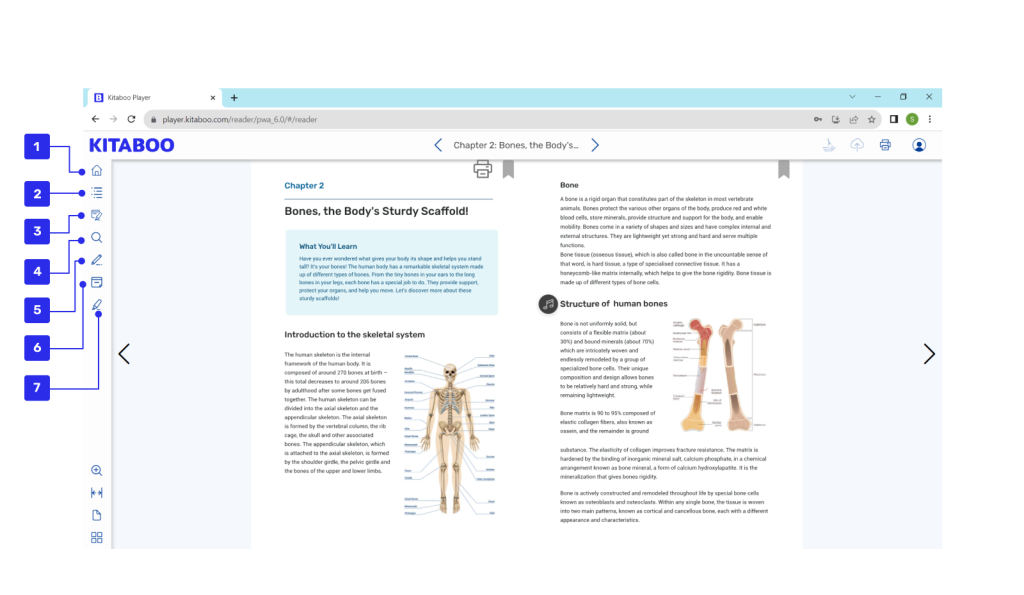
- Back to Shelf : Takes you back to the bookshelf where you can read and add ebooks and other resources.
- Table of Content : Opens the Table of Content by which you can quickly navigate to any part of the ebook.
- My Data : Lists notes and highlights – both yours, as well as those shared with you.
- Search : Lets you search for and find content in the ebook.
- Pen Tool : Allows you to annotate while reading, and also to answer assessments in the book.
- Add Note : Enables you to add a note by clicking/tapping on the Note icon. These notes are on a page.
- Zoom Tool : Lets you zoom in or out while reading an ebook.

8. Fit to Height/Width : Enables you to view the page in “Fit to Width” or “Fit to Height” as per your preference.
9. Zoom Tool : Lets you zoom in or out while reading an ebook.
10. Two Page View : Allows you to toggle between a single-page mode or a two-page mode for viewing your content.
11. Thumbnail View : Lets you browse the book by using the large thumbnails that help you easily identify and navigate to the desired page.
12. Back : Lets you go back to the previous chapter.
13. Next : Lets you go to the next chapter.
14. Profile : Opens a profile menu that contains user’s information.
15. Print : Allows you to print a content page or an entire range of pages.
16. Submit : Allows you to submit the UGC data.
17. Clear : Lets you clear the applied UGC data.
18. TTS : Starts the Text-to-Speech functionality.
1. Table of Contents in Fixed Layout Ebooks
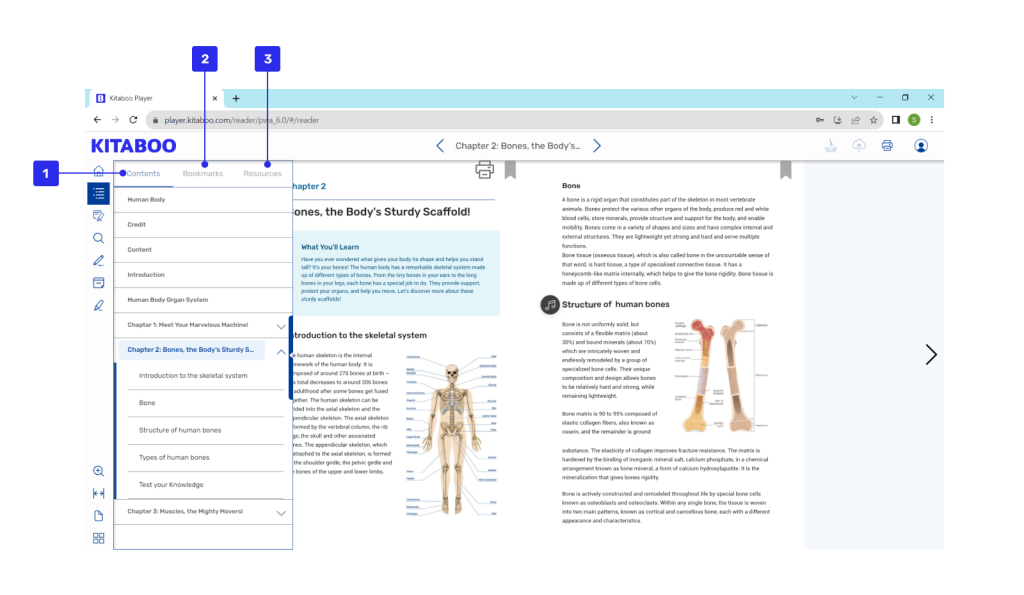
A Table of Content (TOC) groups the content and resources used in a book hierarchically so that you can access them easily. You can also navigate to the desired content via index terms and bookmarks.
1. Table of Contents : Student can view all the chapters or subchapters of that particular content in this panel.
2. Bookmarks : All the bookmark data created by student will be displayed in this panel.
3. Resources : All the resources/markups added in the ebook will be visible in this section.
1.1 Accessing the Table of Contents (TOC):
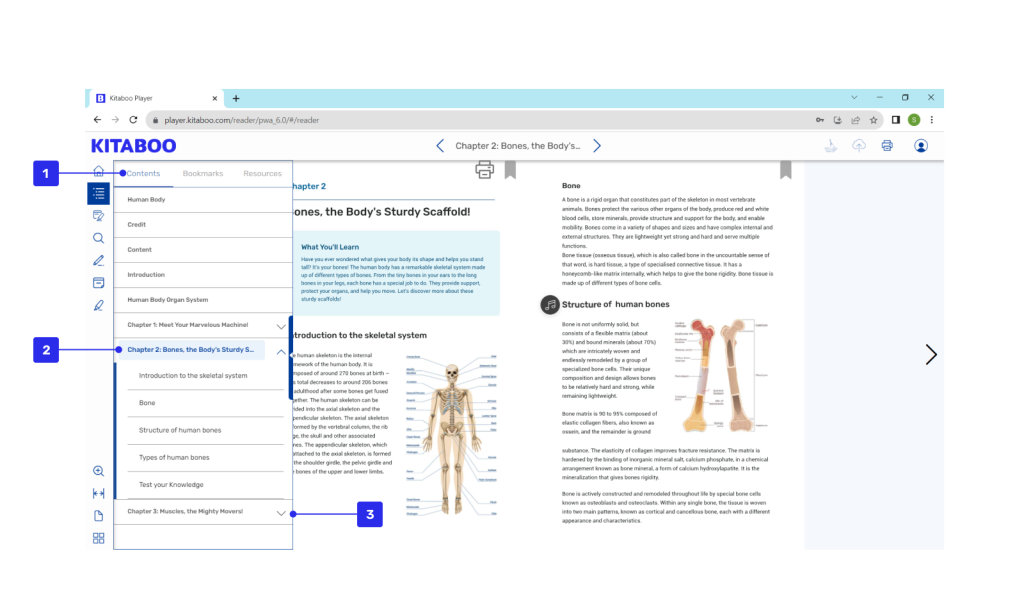
- Accessing TOC: When student opens the TOC panel, the Contents tab opens by default, displaying a tabular list of content with three to four levels (e.g., chapters, topics, subtopics).
- Navigating : Select a TOC element like a chapter or topic to jump directly to that section.
- Expand Sub-chapters : Pressing the expand/collapse button will show/hide the sub-chapters available.
1.2 Bookmarks in Fixed Layout Ebooks
In the Kitaboo, bookmarks allow student to mark specific pages in theirr eBook for easy access later. This feature helps student quickly return to important sections or favorite pages without having to search through the entire book. Bookmarks are a simple way to keep track of key points and organize reading or study sessions.
1.2.1 How to add Bookmark in Fixed Layout Ebooks

Navigate to the page you want to bookmark.
- Tap the Bookmark Icon : Select the Bookmark icon at the top of the page.
- Text Box : Student can add their desired name for that particular bookmark in the text box.
- Add : Clicking on add will save the bookmark for that particular page.
Student can can access it later from the Bookmarks section in the app.
1.2.2 How to Access Bookmarks in Fixed Layout Books
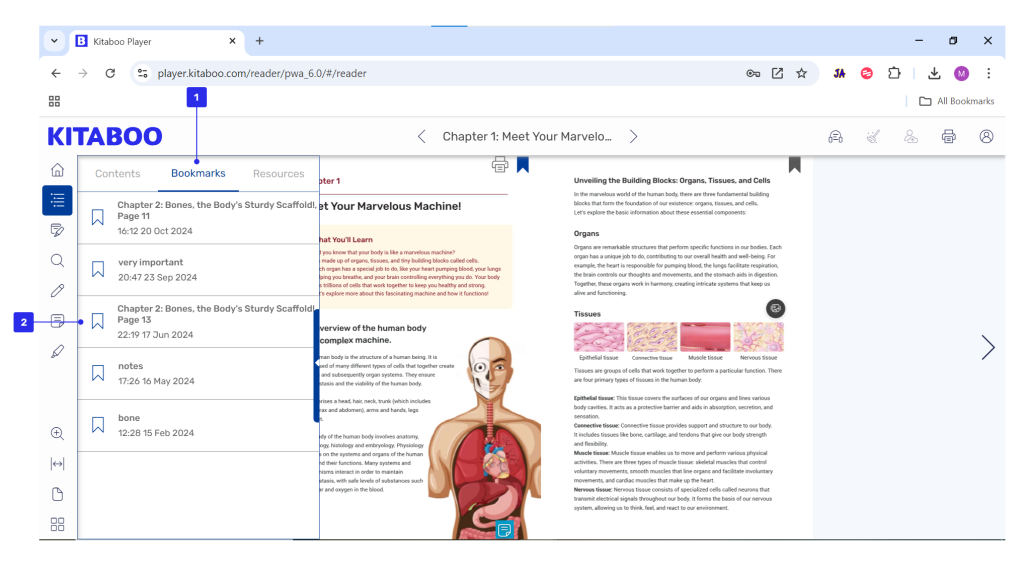
- Accessing Bookmarks: Bookmarks are organized under the Bookmarks tab in TOC panel. Select the Bookmark tab to view them.
- Navigating to Bookmarks: Choose a bookmark to go directly to the bookmarked page of that content section.
1.3 Resources in Fixed Layout Ebooks
Resources or markups are interactive resources which are added as an enrichment to the content. Resources can be in the form of a image, video, hyperlink, audio, scorm activity etc. These resources provide a deep insights of the topics in the ebook.
1.3.1 How to Access Resources in Fixed Layout Ebooks
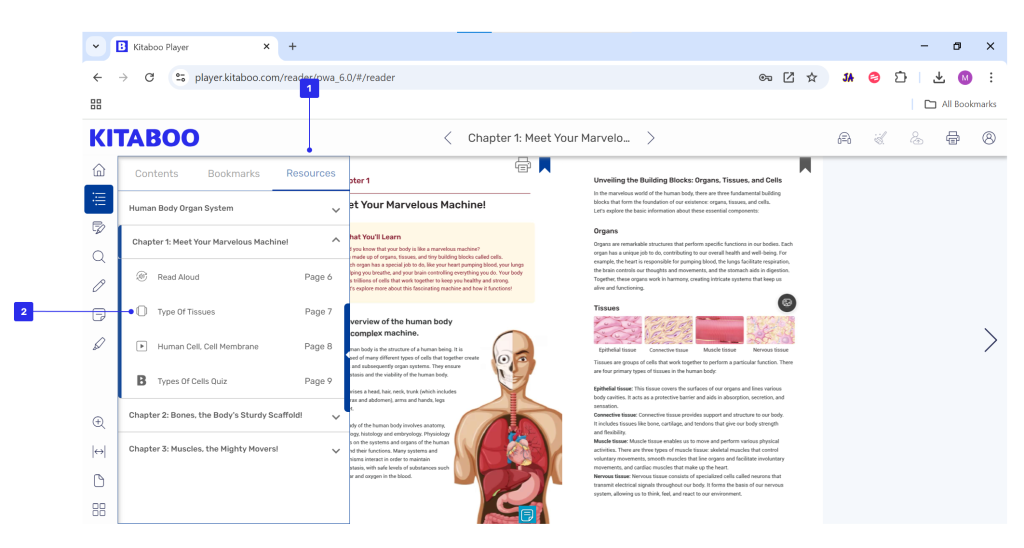
- Accessing Resource: Resources or markups are organized under the Resources tab in TOC panel. Select the Resources tab to view them.
- Navigating to Resources : Choose a resource to go directly to the page of that content section where resource is present.
2. My Data in Fixed Layout Ebooks
The Kitaboo Reader allows you to do more than just creating notes and highlights. Sharing and organizing your data like notes, highlights etc. as well as the conversation threads becomes much easier with the help of Kitaboo Reader. They are always only a tap away. You can also collaborate with others by using the Kitaboo Share function.
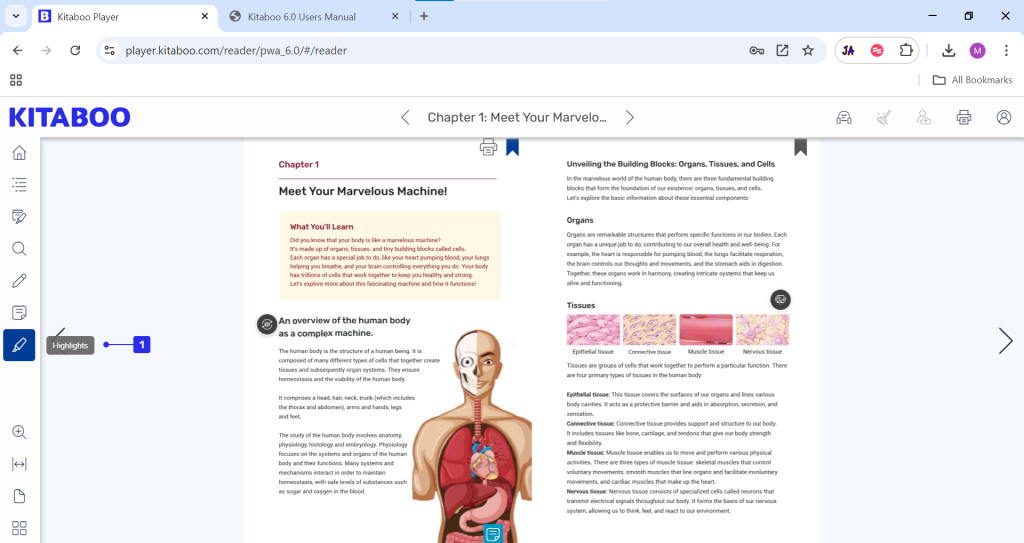
1. My Data : Click on “My Data” button to open the panel.
2. Highlights : This tab will show all the highlights that student has added in the particular content.
3. Notes : This tab will show all the notes the student has created and shared with him/her.
4. Filter : Student can filter the notes and highlights based on their color using this.
2.1 Highlights in Fixed Layout Ebooks
In the Kitaboo, highlights allows student to mark important text within their eBook. This feature helps them emphasize key information, making it easy to revisit crucial sections during study or review. Student can create color-coded highlights to categorize different types of information, making it simpler to organize their notes and study efficiently. Highlights can also be accessed later, providing a quick way to find important parts of their book without having to search through the entire content.
2.1.1 How to add Highlights in Fixed Layout Ebooks
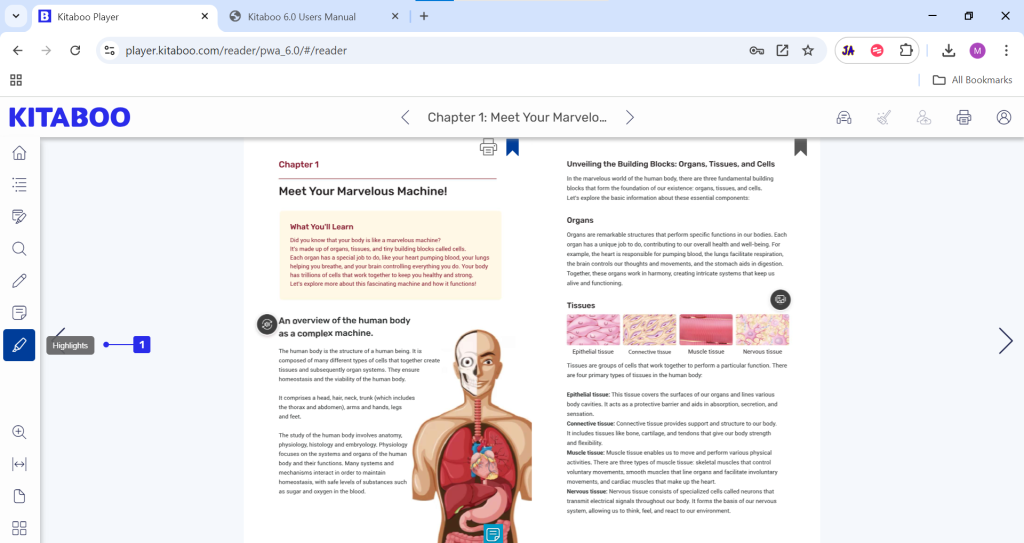
1. Highlights Button : Click on the highlights button in the left panel to select the highlights tool.
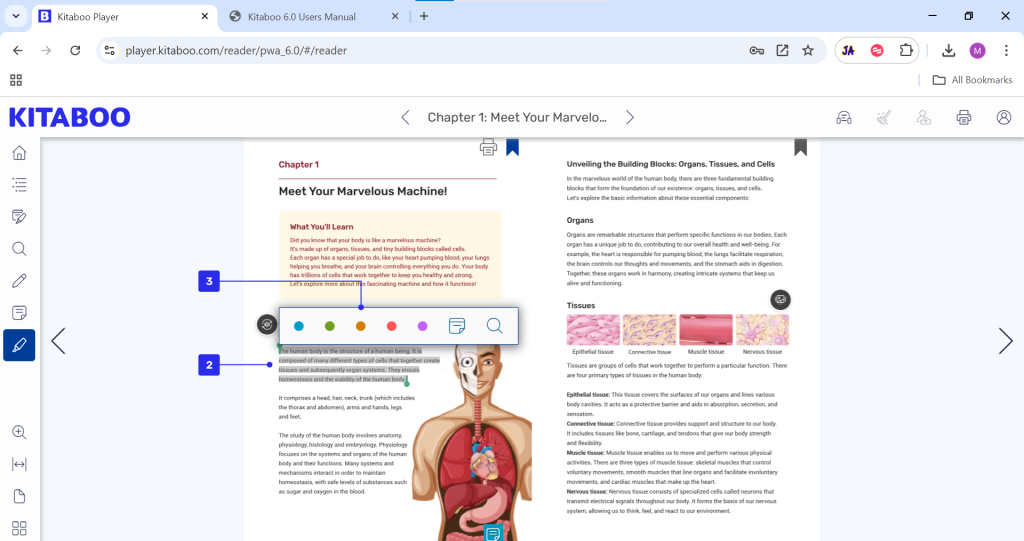
2. Select Text : Student can now select the texts from the ebook that they want to highlight using mouse cursor.
3. Color : Student can even change the color of the highlight from the color options in the top panel.
2.1.2 How to access Highlights in Fixed Layout Ebooks
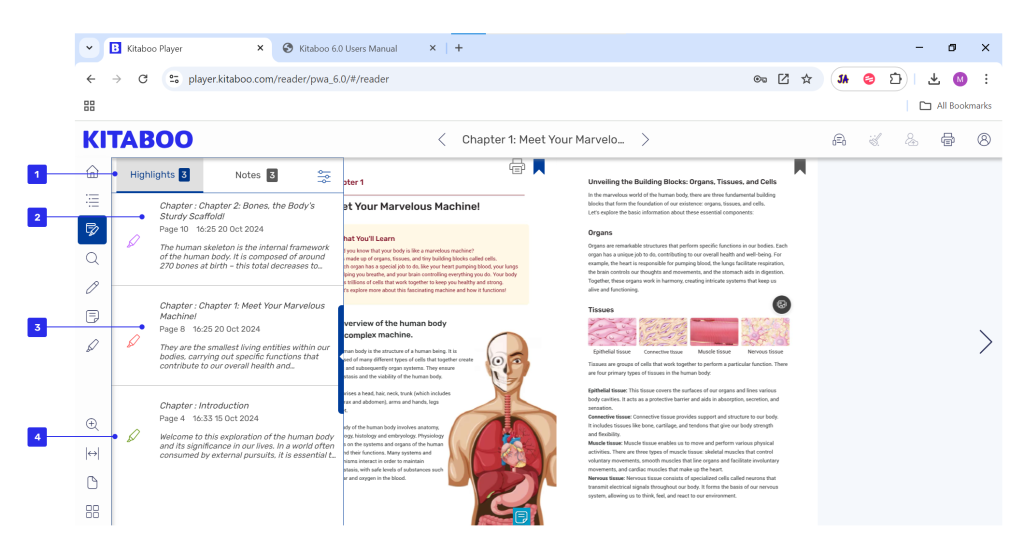
- Accessing the Highlights : The student can access all the highlights that are added by selecting the “Highlights” tab in My Data section.
- Chapter Name : Shows the chapter name in which the particular highlight is added.
- Date & Time : Shows the date and time of the highlight creation.
- Color : The color of the highlight icon denotes the color of the highlight added.
2.1.3 Filter for Highlights in Fixed Layout Ebooks
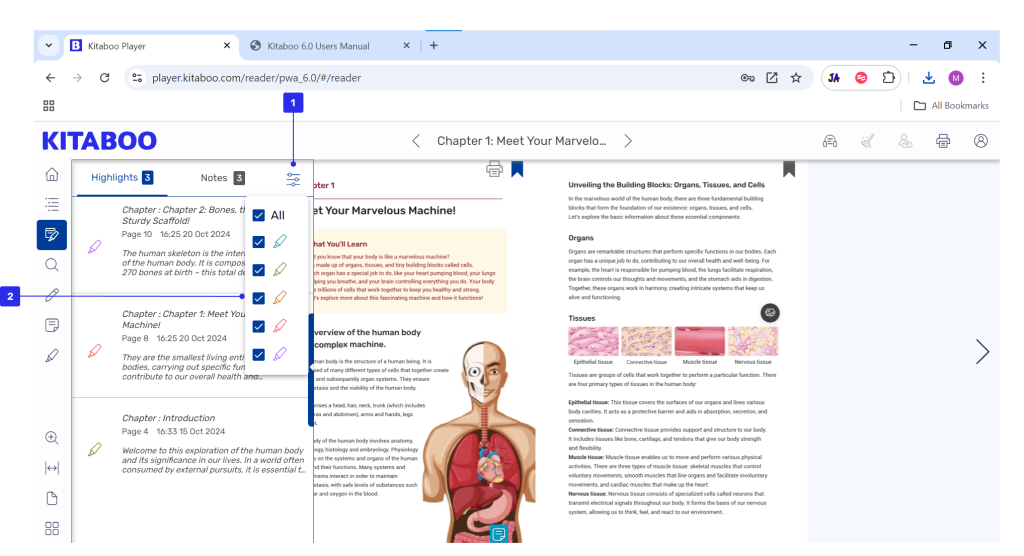
1. Filter : Student can filter the highlights based on the color of the highlights by clicking on “Filter” icon in the My Data section.
2. Highlight Color : Student can check/uncheck the color box of highlights to filter the highlights of required color.
2.2 Notes in Fixed Layout Ebooks
The Kitaboo app allows users to add sticky notes directly onto eBook pages, providing a convenient way to jot down thoughts, reminders, or insights while reading. These digital sticky notes can be placed anywhere within the text, making it easy to reference important information or personal comments. Users can customize, edit, or delete these notes as needed, making them a valuable tool for study, review, or collaborative learning.
2.2.1 How to add Sticky Notes in Fixed Layout Ebooks
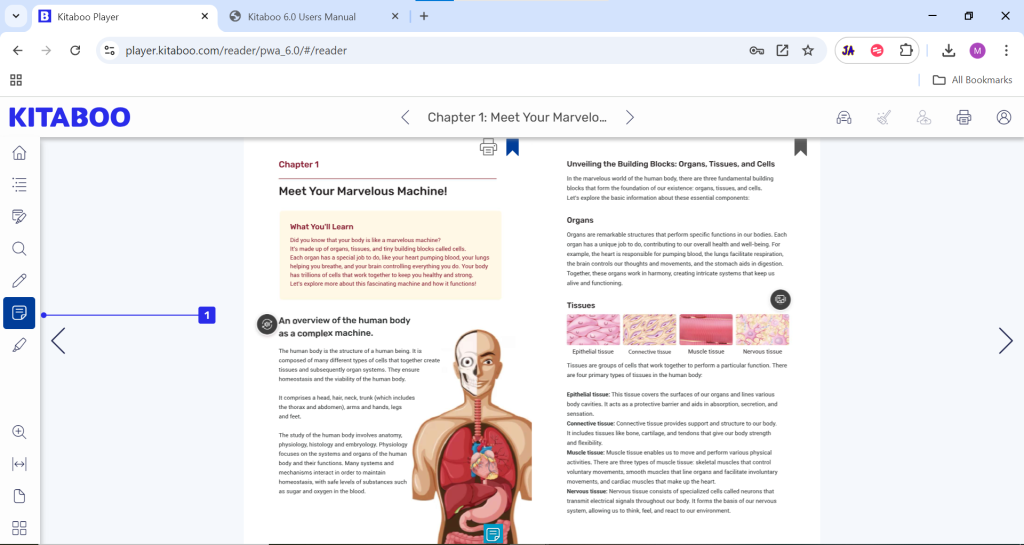
1. Sticky Notes Button : Click on the Sticky Notes button in the left panel to select the Sticky Notes tool.
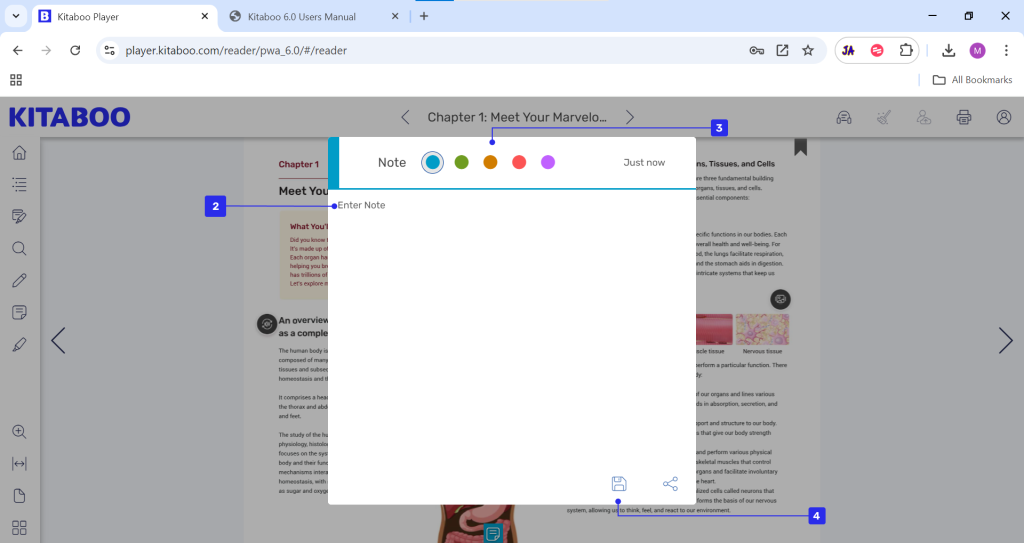
Now click anywhere on the ebook where you want to add sticky notes and it open a notes popup panel as above.
2. Write Your Note : Type your note in the text box that appears.
3. Color : You can change the color of the sticky notes icon from the color options present in top panel.
4. Save the Note : After writing your note, tap Save. The note will be attached to the selected text.
5. Share Note : Student can share the note with teacher or other fellow students using the share button.
2.2.2 How to add Contextual Note in Fixed Layout Ebooks
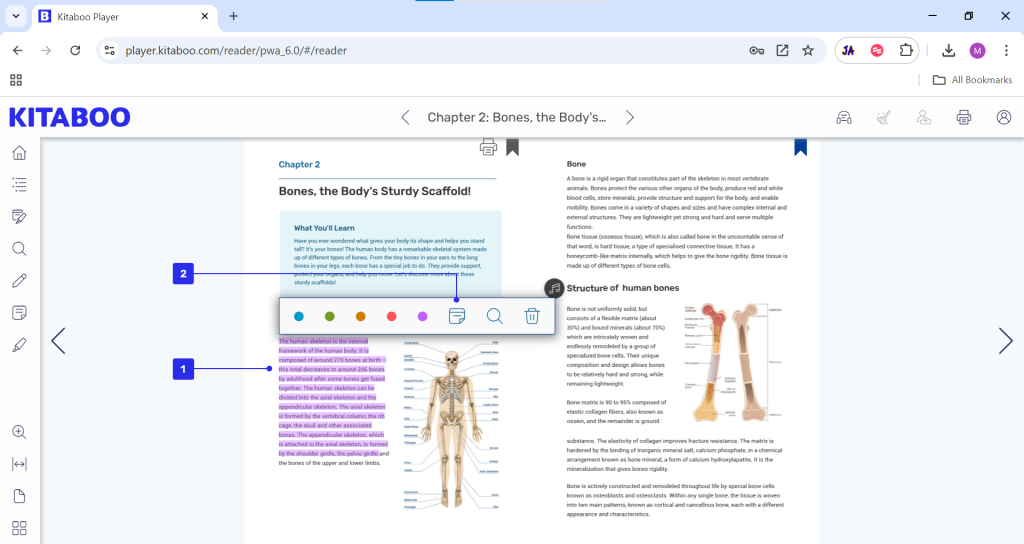
1. Highlight: Click on the highlight where you want to add contextual notes. It will open a pop-upfor adding the notes.
2. Tap on ‘Note’: From the pop-up menu that appears, select the Note icon option. It will open the Note text box as below

3. Write Your Note : Type your note in the text box that appears.
4. Color : You can change the color of the sticky notes icon from the color options present in top panel.
5. Save the Note: After writing your note, tap Save. The note will be attached to the selected text.
6. Share : Student can share the note with teacher or other fellow students using the share button.
2.2.3 Accessing the Notes in Fixed Layout Ebooks
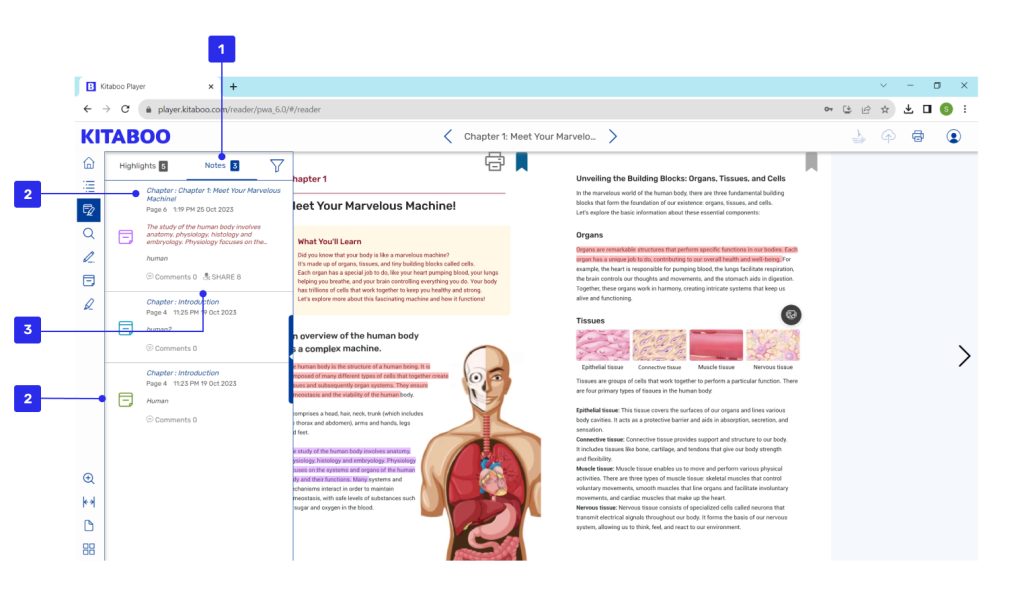
- Accessing the Notes : The student can access all the notes that are added and shared by selecting the “Notes” tab in My Data section.
- Chapter Name : Shows the chapter name in which the particular highlight is added.
- Comment & Share : Shows the comments added or to how many students/teacher the note is shared.
- Color : The color of the note icon denotes the color of the note added.
2.2.4 Filter for Notes in Fixed Layout Ebooks
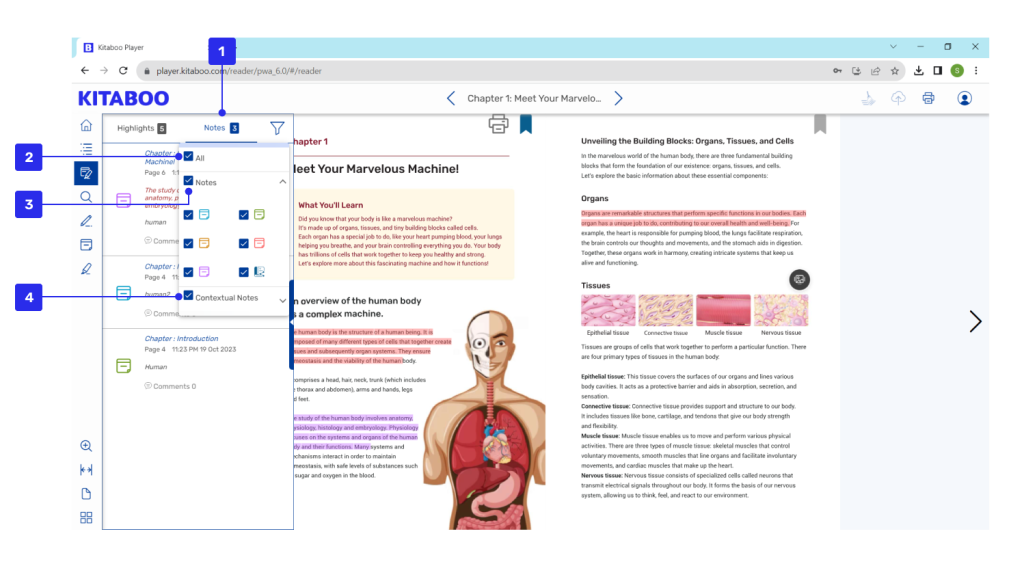
1. Filter : Student can filter the notes based on the type of note or based on the color of the notes by clicking on “Filter” icon in the My Data section.
2. All : Student can select the “All” checkbox if they want to view all the notes.
3. Notes : Student can select the notes checkbox to view all notes.
4. Contextual Notes : Student can select the contextual notes checkbox to view all contextual notes.
2.2.5 Adding Comments to Notes in Fixed Layout Ebooks
The student can add comments to the notes shared by the student with the teacher once the teacher adds comment to that particular note.
Student can click on the “Comment” button to add their comment reply to the teacher.
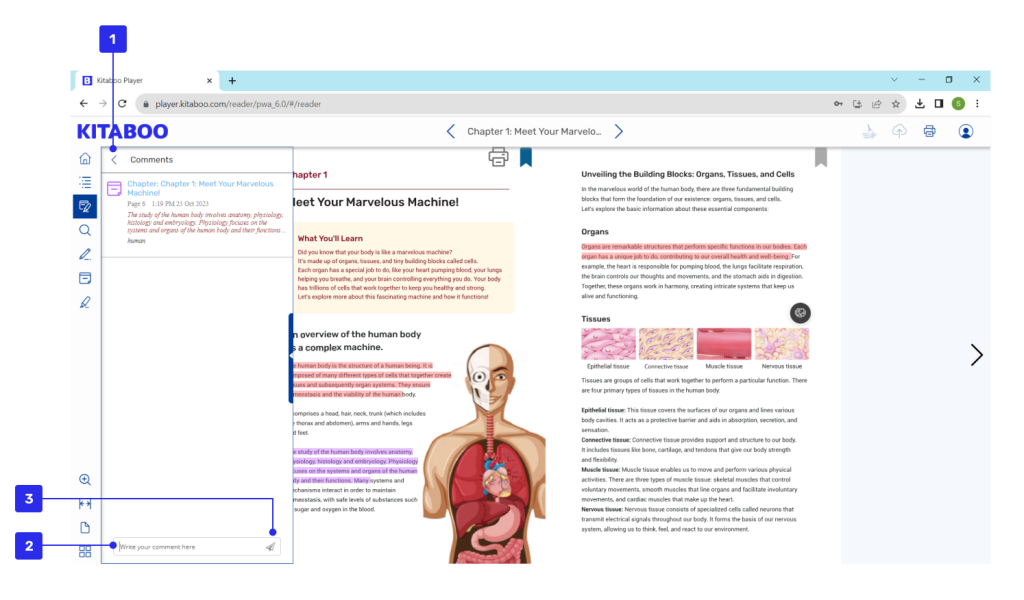
Once the student clicks on the “Comment” button as above it will open a panel inside the “My Data” column.
1. Back : By clicking here the student will be navigated back to the “My Data” panel.
2. Comment box : The student can respond to a comment by typing in the input
field at the end of the pop-up.
3. Send Button : On click or tap of the Send button, the student’s comment will be visible to the user the next time he/she opens the content.
2.2.6 Sharing Notes in Fixed Layout Ebooks
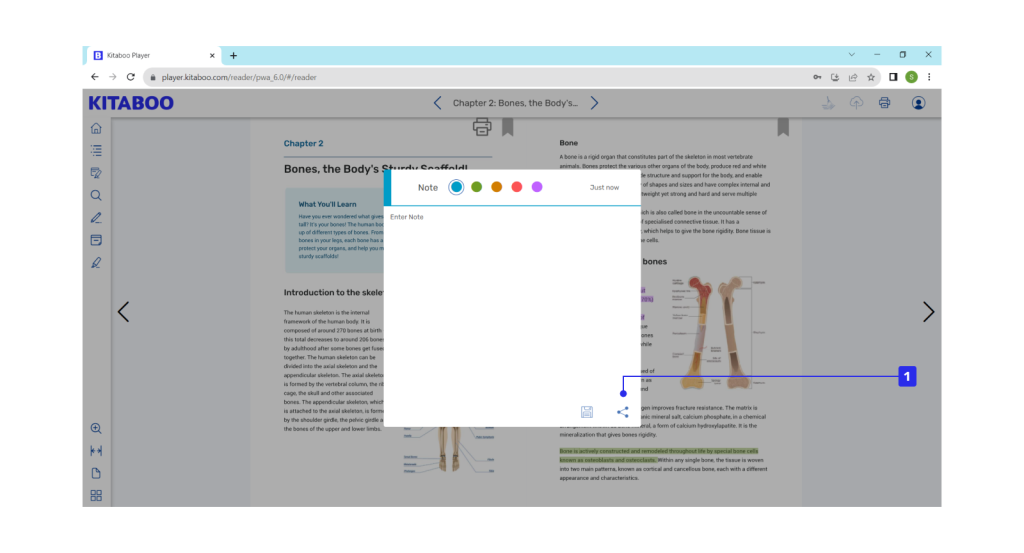
Student can click on the “Share” button to share the note with other students of the same class or with the teacher assigned to that class.

1. Select Class : The student can select the class in which they want to share the note with teacher.
2. Done : Once all the student and teacher are selected for the note sharing then student can click on “Done” to share the notes.
3. Cancel : The student can cancel the note sharing using the “Cancel” button.
4. Back : Student can go back using the back button.
3. Keywords Search in Fixed Layout Ebooks
The search functionality in the Kitaboo allows student to quickly find specific keywords or phrases within the content. By entering a keyword into the search bar, student can view all instances where that word appears, making it easier to locate important information or revisit key sections. This feature helps streamline study process and saves time by guiding students directly to the content they need.
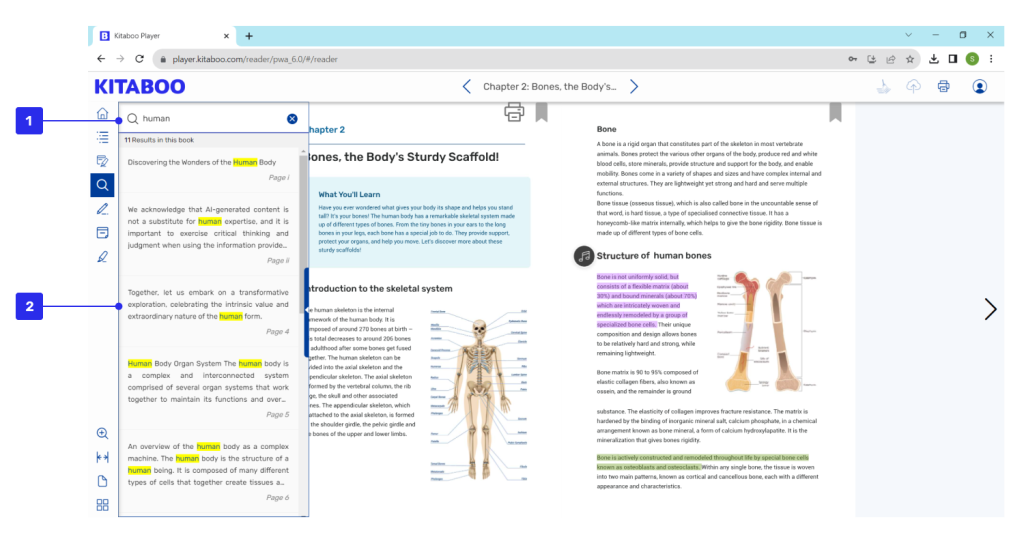
1. Enter the keyword : The student need to enter the keyword they need to search in the content and press enter.
2. Search responses : All the matching responses for the keyword would be displayed in the panel below. Student can click on any instance they want and they will be redirected to the page where the keyword is present.
4. Pen Tool in Fixed Layout Ebooks
Student can use the Pen tool for inserting on-page annotations. As a student, you can submit your annotations to your instructor, and the latter can annotate on students’ ebooks for them to review.
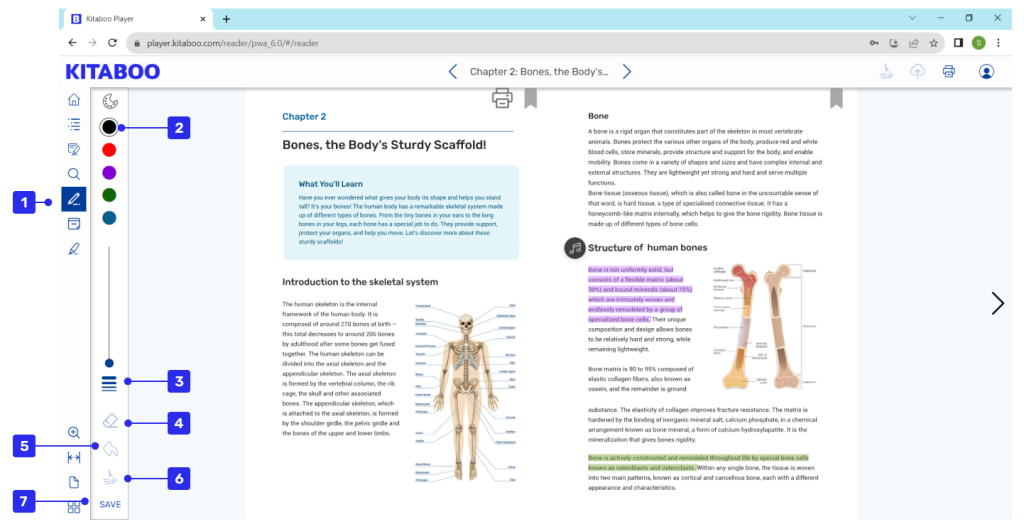
1. Pen Tool : Click on the Pen Tool to open the pen tool pop-up.
2. Color : Student can select the color of the pen tool from given options.
3. Thickness : Student can adjust the thickness of the pen tool using the thickness tool.
4. Eraser : Student can erase the pen tool data using the eraser data.
5. Undo : Student can undo the pen tool data using the “Undo” button.
6. Clear All : Using this all the pen tool data on the page will get cleared.
7. Save : After adding pen tool data, student can save the pen tool annotation for later usage.
5. Navigating the Fixed Layout Ebooks
The Kitaboo app offers intuitive page navigation options for eBooks, allowing users to easily move through the content. Features like chapter navigation, thumbnail view, page slider, and page-jump functionality enable quick access to specific chapters, pages.
5.1 How to Navigate through Chapters in Fixed Layout Ebooks
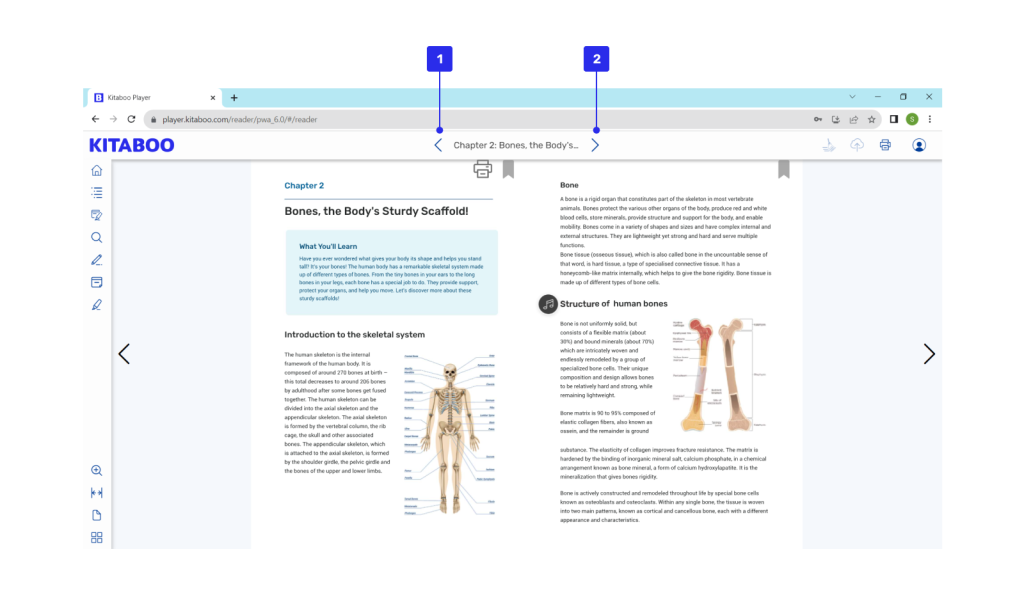
Student have option to navigate to different chapters using the chapter navigation option present on the top bar of the reader.
1. Previous Chapter : Student can jump back to previous chapter using the “Previous Chapter” button.
2. Next Chapter : Student can jump back to next chapter using the “Next Chapter” button.
5.2 How to Navigate through Pages in Fixed Layout Ebooks
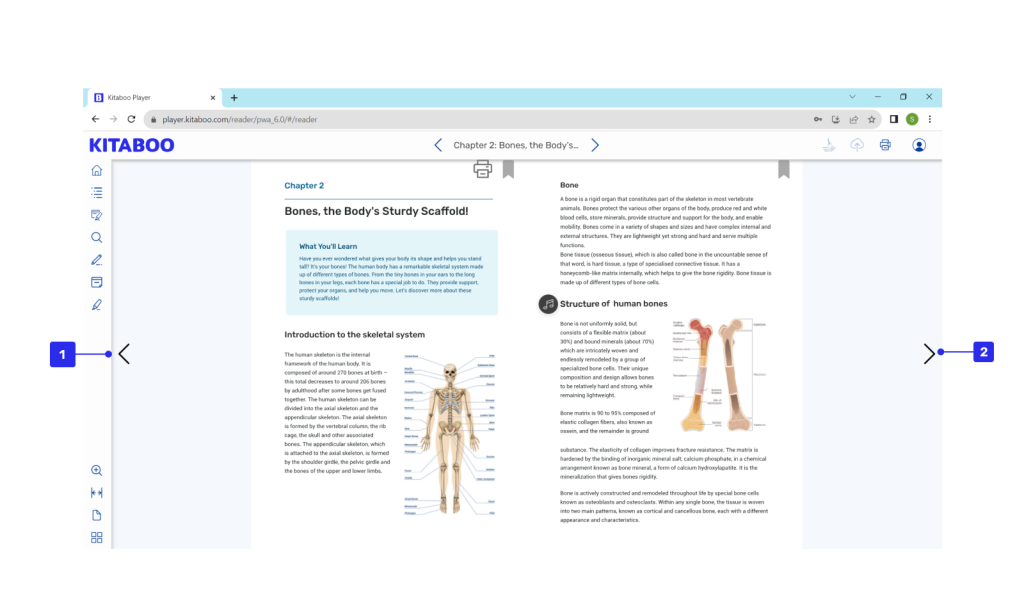
Student have option to navigate to previous or next page using the page navigation option present on the top bar of the reader.
1. Jump to Previous Page : Student can navigate to previous page using the “Jump to Previous Page” button.
2. Jump to Next Page : Student can navigate to next page using the “Jump to Next Page” button.
5.3 How to Navigate through Thumbnails in Fixed Layout Ebooks
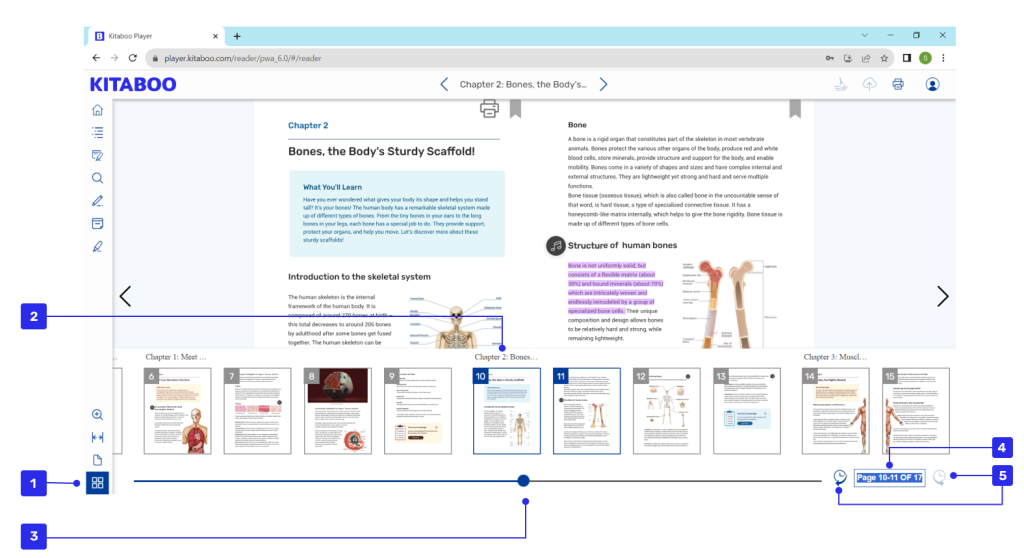
1. Thumbnail : Click on the “Thumbnail” button to open the thumbnails panel.
2. Thumbnail View Navigation : Student can select the thumbnail of any page to navigate to that particular page. Also, the page opened in the reader is highlighted in the thumbnail view.
3. Thumbnail Slider Navigation : Student can use this slider for viewing all the thumbnails of the page and navigate to any page using it.
4. Jump to Page Navigation : Student can jump to any page number by entering the page number in the dialog box and they will be redirected to that page.
5. Page History : Student can return to the previously visited page with the help of the History icons. Their surfing history gets saved post navigation to a page.
6. Content Viewing options in Fixed Layout Ebooks
Kitaboo’s content viewing features provide flexible options to enhance the reading experience. Users can switch between Single Page Mode for focused reading or Double Page Mode to view two pages side by side, mimicking a physical book. The Zoom feature allows for closer inspection of text or images, while Fit to Width and Fit to Height adjust the content to fill the screen horizontally or vertically, ensuring optimal readability on different devices and screen sizes. These features offer a customizable and comfortable reading experience.
6.1 Using Page Zoom in Fixed Layout Ebooks

1. Zoom Button : Click on the “Zoom” button to open the zoom panel.
2. Zoom Slider : Move the slider to either zoom in or zoom out the contents.
3. Reset : To reset the zoom to original setting student can click on the reset button.
4. Close : To close the zoom panel, click on the “Close” button.
6.2 Viewing the Fixed Layout Ebooks in Fit-to-Height Mode
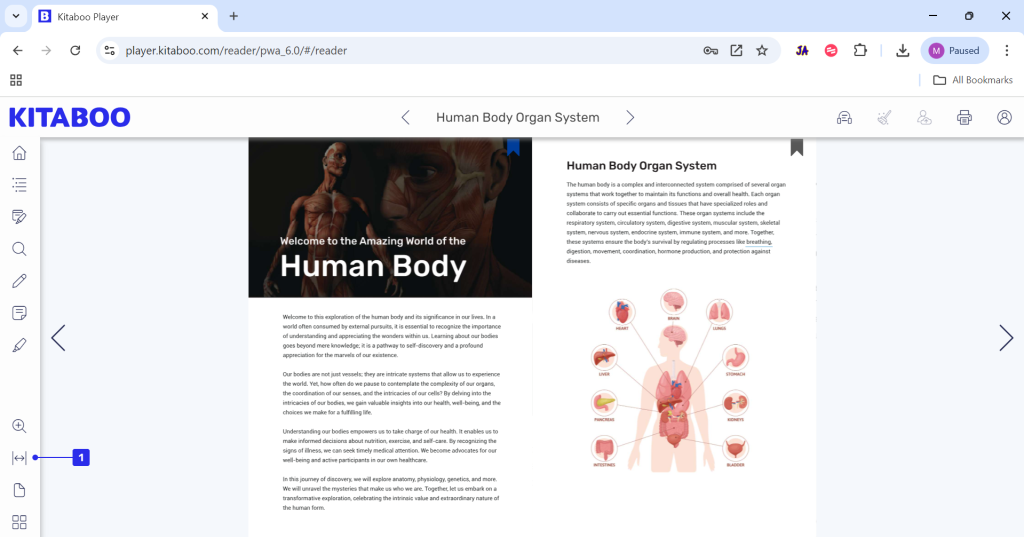
1. Fit-to-Height : Clicking on this will view the content in fit-to-height mode.
6.3 Viewing the Fixed Layout Ebooks in Fit-to-Width Mode
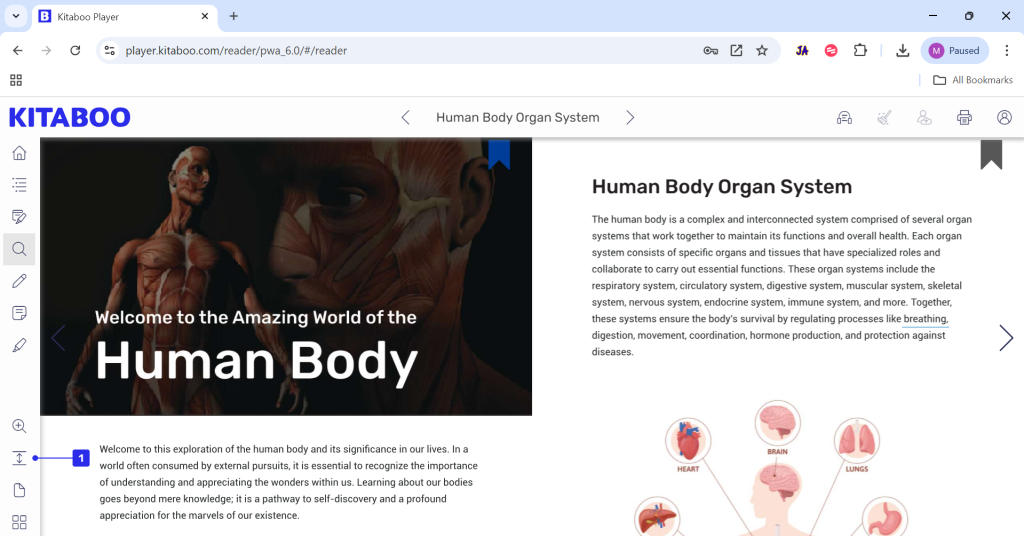
1. Fit-to-Width: Clicking on this will view the content in fit-to-width mode.
6.4 Viewing the Fixed Layout Ebooks in Single Page Mode
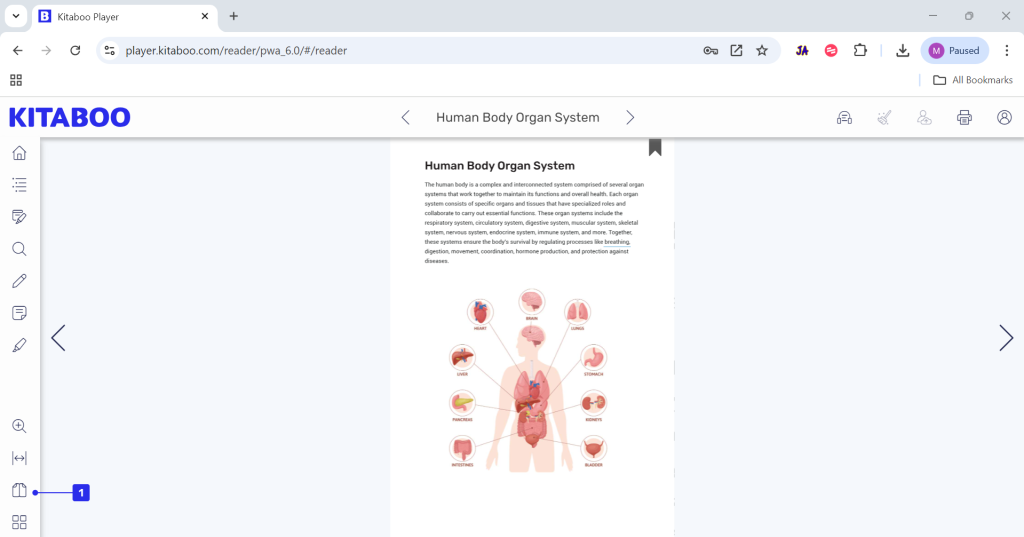
1. Single Page Mode : Single page mode can be enabled for viewing experience.
6.5 Viewing the Fixed Layout Ebooks in Double Page Mode
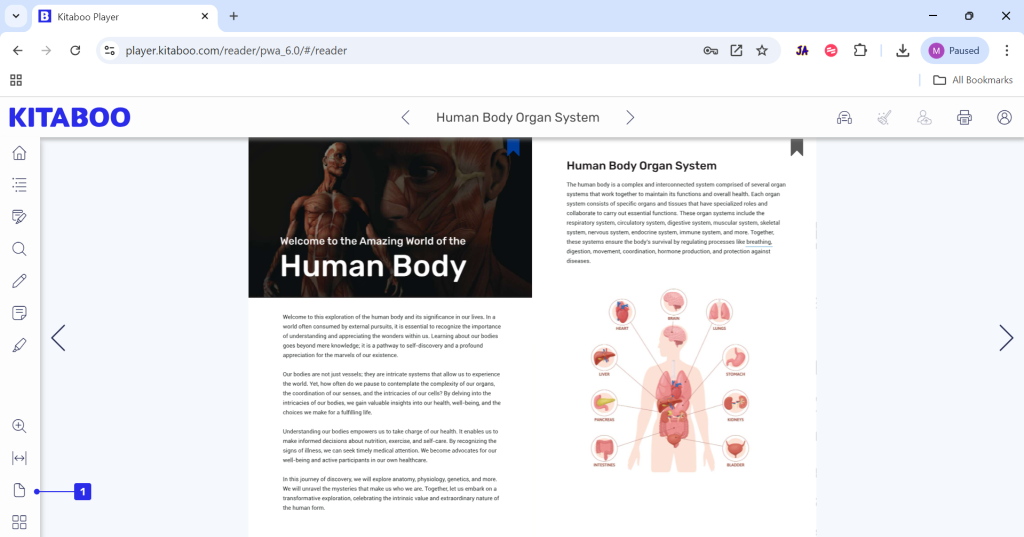
1. Double Page Mode : Double page mode can be enabled for viewing two pages side by side like a physical book.
7. Text-to-Speech (TTS) in Fixed Layout Ebooks
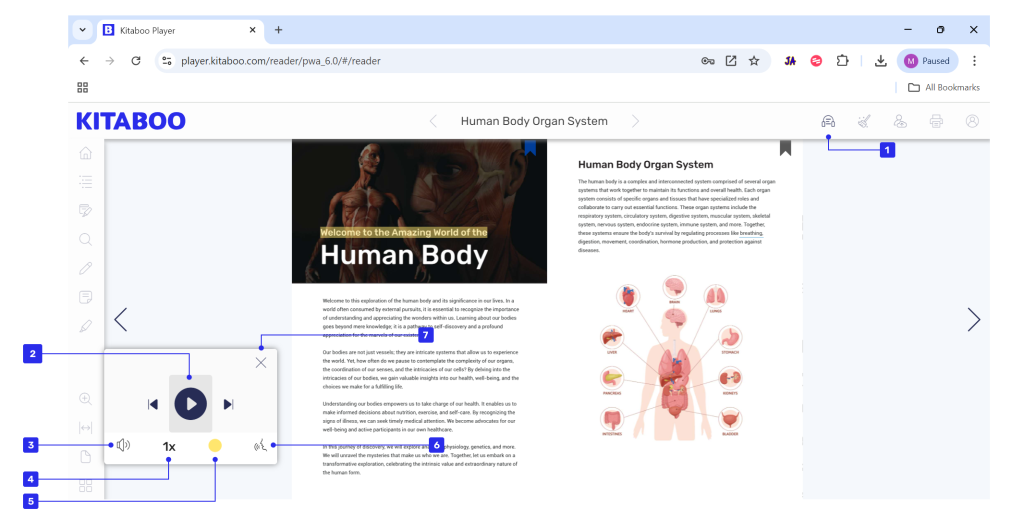
1. TTS button : For using this functionality student need to click on the TTS icon and it will open a TTS panel at the bottom of the page.
2. Control Buttons : Student can Play/Pause or go to previous or next sentence using the player controls.
3. Volume : Student can adjust the volume of the player using the volume button.
4. Narration Speed : Student can increase or decrease the narration speed of the voice being played using this.
5. Highlight Color : Student can change the highlight color of the sentence that is being played.
6. Change Voice : Student can change the voice of the the player to suit their preferences.
7. Close : Cancel button will close the player panel.
8. Using Print functionality in Fixed Layout Ebooks
The print functionality in the Kitaboo allows users to print specific sections or pages of an eBook, depending on publisher permissions. This feature enables users to create physical copies of important materials for offline reading or study. It offers flexibility by letting users select page ranges for printing, ensuring that only the most relevant content is printed, while adhering to any restrictions set by the content provider.
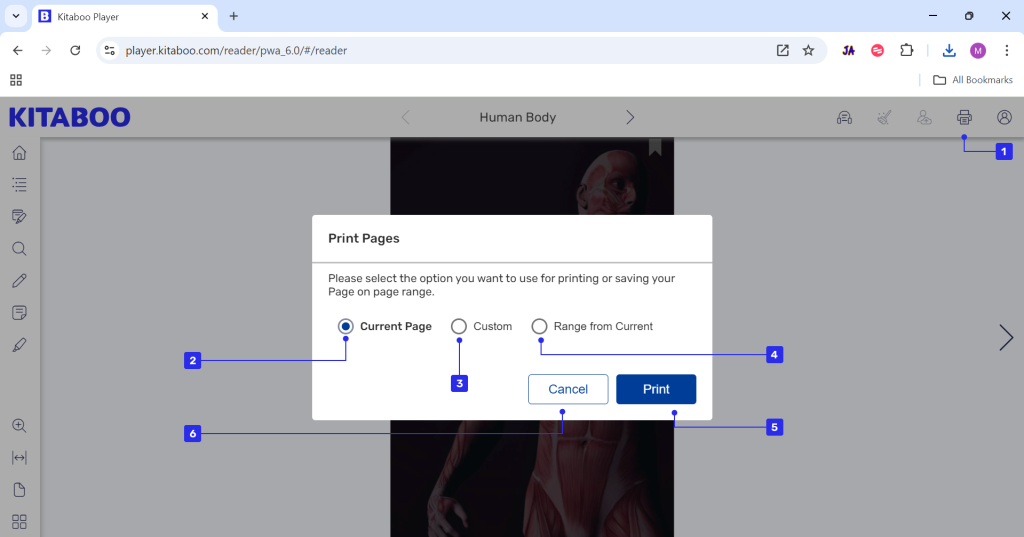
1. Print Button : Click on the “Print” button on the top bar of the reader. It will open a print page pop-up as shown above.
2. Current Page Print : Student can select this option to print the current page on the reader.
3. Custom Print : Student can use this option to print different pages. They need to enter page number separated by comma to print those pages.
4. Range from Current Print : Student can enter number of pages from current page on reader that need to be printed.
5. Print : By pressing the “Print” it will open the print options that are connected with the device to print the pages.
6. Cancel : Student can cancel the print functionality by pressing the cancel button.
9. Submitting Student Data in Fixed Layout Ebooks
For grading the students, there can be assessments added inside the ebook. Student need to complete these assessments and submit them for the teacher to review and grade them. Assessments can be of many types like MCQ, FIB, long answers, shorts answers etc.
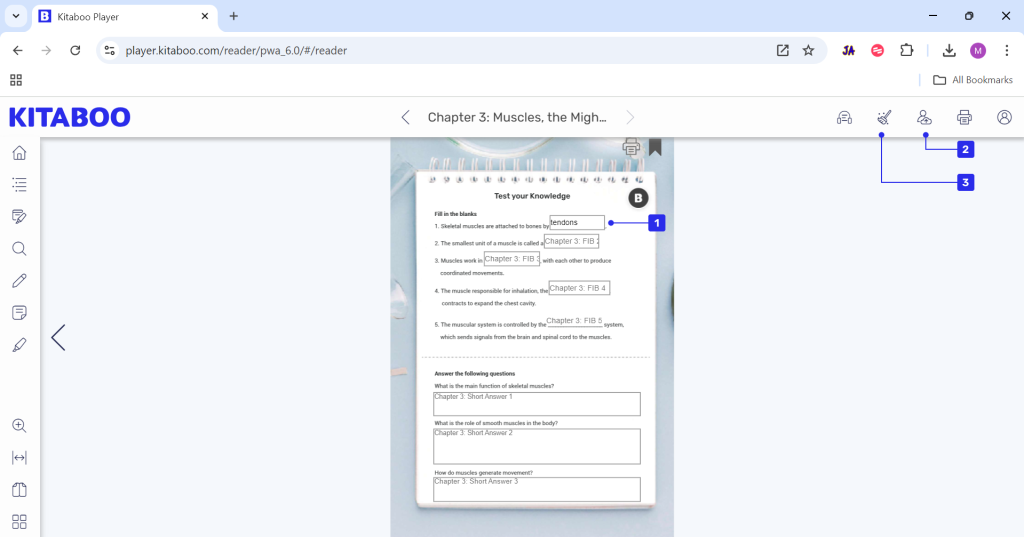
For assessment activity as shown above, student need to enter their answers in the “FIB” box in one word and long answers in the bottom questions.
1. Student Data : Student need to enter answers of the questions wherever applicable.
2. Submit All: After entering the answers wherever applicable, student need to submit that to teacher for further reviewing or grading.
3. Reset All : Before submitting the data, student have option to reset the data they have entered.
